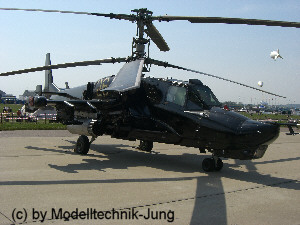The orginal
The Kamov Ka-52 is a russian attack helicopter unit. It has the typical Kamov characteristic, the double counter-rotating rotor (coaxial rotor), which makes the tail rotor redundant. The KA-52 (Alligator) is the double-seater version of the attack helicopter unit Kamov 50 Hokum (codename werewolf) that had been developped over a period of 10 years by the russian military.
One of the Ka 52’s characteristics is the modified cockpit that has got 2 seats next to each other. The front section of this unit had been completely rearranged to install electronic equipment, high-tech radar and controls of weapon equipment.
The Hokum as well as the Alligator are powered by two Klimov shaft turbines that are incorporated above the stubby wings. On the aerofoils there are 4 outer cantilevers. The pilot and the operator of the weapon systems sit next to each other..


This fast and easily manoeuvrable helicopter has a particularly good armouring of the cockpit and other vital parts of the helicopter. The 350 kg armouring can resist 20 mm calibre fire from shortest distances. Since the helicopter has not got a tail rotor, it is still manoeuvreable, in case of strikes in the rear. The rotor blades can be launched and the pilot can save himself by activating his ejection seat.
A crucial advantage of the coaxial arrangement of the rotor is a high agility of the helicopter. Because of the lacking tail rotor a higher payload can be lifted. The reason for this is that a common main-/tail-rotor arrangement absorbs approximately 15% of the total power input for the tail rotor’s power. A coaxial rotor absorbs the power without this kind of loss. So the power is available for both rotors.
While the ouput figures of the single-seater Ka-50 continued to be low, Kamov presented the prototype of the new double-seater attack helicopter unit Ka-52 to the public in September 1996. The main difference was a newly designed fuselage with the seats of the pilot and the seat of the operator of the weapon systems next to each other. Nearly 85% of the Ka-50 construction could be used for the Ka-52 without any further modifications. So planning and production costs could be reduced considerably. According to Kamov the Ka-52 is not a version of the Ka-50 for nocturnal fights. It is rather a supplement to the Ka-50’s operations. Its main missions are reconnaissance under all kinds of weather conditions, allocation of military targets and coordination of a group of attack helicopters. A special data communication system had been installed for coorperation with ground forces.
|